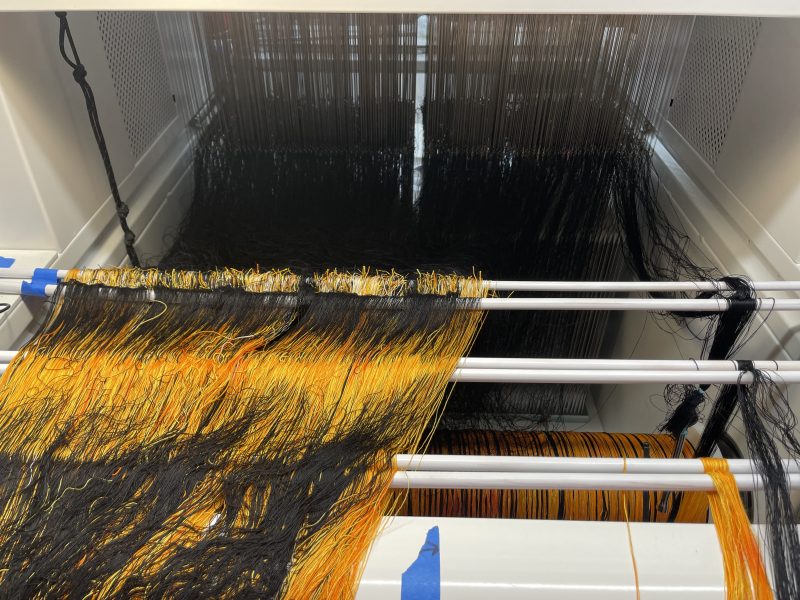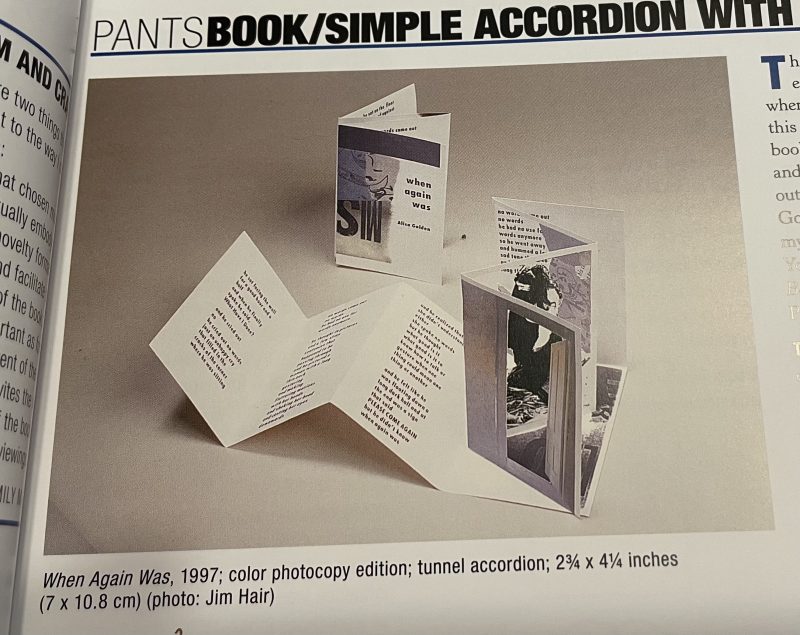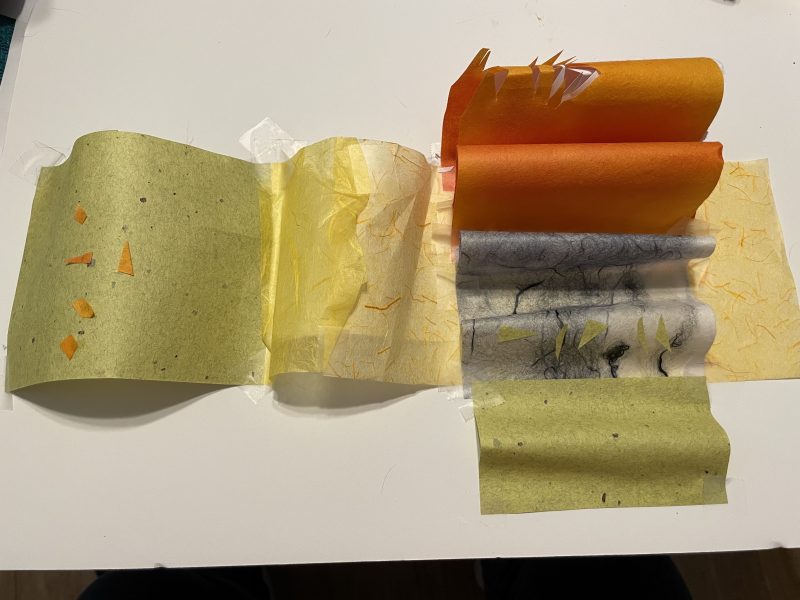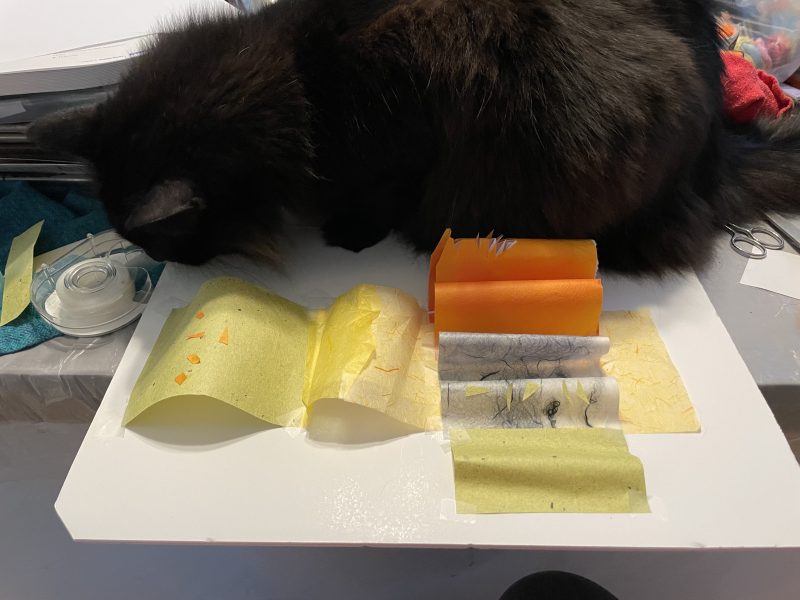After almost two months, I am alllllmost done tying on the Fire warp. 92.86% done, according to my calculations:

I’m so close I can practically taste it. That’s the good news. The bad news is that I have found some weak threads – apparently not all of the 20/2 mercerized cotton was as strong as I thought it was. I’m hoping it doesn’t turn out to be a problem across the entire warp. If it turns out to be unweavable hara-kiri may be a serious possibility. Of course there are options for fixing weak warps post facto, but do I really want to risk getting hairspray or bits of warp sizing into those oh-so-tiny vacuum valves at the top of each heddle? Yikes.
Anyway, now that I’m close to finishing, I’m suddenly much more interested in laboring away at it. Two more inches of warp threads (about 180 threads) is about two hours’ work, so I should be able to finish that in the next day or two. After that it will be another eight or ten hours of pulling through, sleying the reed, and tying on. And then I can get to the delights of debugging! Given how little free time I have, it will probably be another 2-3 weeks before I can actually get to weaving. The sheer number of threads (2,640) in each of these warps gives “slow weaving” a whole new meaning.
Meanwhile, I have been seeking out and germinating seeds of new ideas. This time I have been browsing through Making Handmade Books by Alisa Golden, which is a collection of 100 book styles with instructions for making each. I came across this amazing and very simple book early on in the collection, and found it inspirational:

The structure is a single sheet of paper, cut down the center and cleverly folded so that the bottom half folds into the “book”, then the top half folds abruptly up and becomes the three-dimensional “pop-up” on the right side.
This made me think of rolling hills, tall trees, and towers of flame. Fire has been much on my mind lately, as it has been for many Californians. The terrible drought is now in its second year, and we got so little rain this past year that some wildfires have already started – and we’re not even out of spring yet. Typically spring is the growing season, when the hills are green; in summer the hills dry out and turn to gold. Fire season is in the fall, when everything has died and dried out. So wildfires in May are virtually unheard of – and a terrible sign, both individually and of the effects of climate change.
The folds of paper reminded me of the rolling, grassy hills, covered with flowers (orange California poppies) in spring, then turning golden in summer, and then in fall, sometimes changed abruptly into towers of flame with wildfire. Then, in winter, the rains come, softening the blackened burn scars, and seeds germinate and the cycle starts again. If there’s enough water. Lately, there hasn’t been, and with climate change, it will likely only get worse.
So this has been much on my mind.
Anyway, after a short internal debate familiar to every crafter (“You’re going to use this precious paper for WHAT?” “What, you’re going to save it and never use it for anything?” “Shouldn’t you keep it for better stuff?”), I decided to use some of the Japanese paper samples I’d bought to build some sketches of what I was thinking. I’m not good enough at drawing to sketch it out, I didn’t want to lose the idea, and I didn’t have cheap construction paper on hand to build a model with. I also felt that the idea would be better expressed if I weren’t trying to do it with third-grader materials.
There is always a tension between “saving the good stuff for quality work” and “disrespecting your investment of time and skill as an artist by using shoddy materials”. For finished work, I am strongly on the side of working with the best quality materials you can afford. For initial sketches, though, I will often work with cheaper materials if they get me the same answer. In this case I felt I could think better if I were using better quality materials, even if it were just a sketch. I like to follow my creative instincts, so Japanese paper it was.
Here’s the little model I built:

As you can see, it looks more or less nothing like the book in the photo, except in overall layout. On the left, you have the rolling green hills in spring; they’re dotted with bright orange California poppies (the scraps of orange paper), which are also the state flower of California. Of course, they are also the color of fire, so in some sense they symbolize the idea that fire is built into the land, is part of the natural cycle of the seasons.
As the seasons progress to the right, the hills dry out and become golden yellow, then yellow-orange. In fall, there’s an abrupt shift, and a shift in direction, as the cloth gets folded up and the flip side of the cloth becomes visible. The cloth bursts up into giant flames, which dwindle down and become skeletal ash covering the hills. Green sprouts appear on the ash-covered hills, which then slowly green over the winter, renewing the cycle.
This is, of course, just the seed of an idea, the beginning of a story. There are a ton of loose ends in this little sketch that need to be sorted out. For example: With all the wavy bits, is this still a book? If not, why retain the folded format? Is it relevant to what the piece is “saying”? Does the right-angle turn in the direction of the piece at the right side serve a thematic purpose? (I think it kinda does, because it adds emphasis to the idea of “bursting into flame,” but that warrants closer examination.)
More questions/problems to solve:
- If this is a cycle, then why does it not start and finish in the same place?
- How to work in the idea that climate change is making the cycles more extreme and more destructive? Is that even possible?
- How to create the three-dimensionality? There are several options – wire in the weft, backing the cloth with paper, adding sizing to the cloth
….and lots more.
This is very much a starting point, though an intriguing one.
But, since the first idea is rarely the best one, I plan to do some more brainstorming over the course of this coming week as well.
My apologies, by the way, for the wrinkles in some parts of the model (particularly the yellow and yellow-orange “hill” in the center). It would have come out much more smoothly, except that Someone sat right down on it while I was making it. As was only right and proper, since I was paying too much attention to the piece, and not to the V.I.C. who needed some serious head scritching, petting, and adoration. You can make a VIP wait, of course, but a Very Important Cat is quite a different story.
I couldn’t possibly tell you who it was, of course. But I could, perhaps, offer a small hint.


Tien,
Wow, your idea has so much potential.
And for what it is worth the book ‘A never ending story’ is a book that has a beginning and an end, that is a beginning…
Good luck with the wrap. Step 1 almost done!
Excellent use of fancy paper! It’s visually arresting and the Supervising Kitties know it.
The first place I go when thinking of time as an evolving cycle is to think of a spiral or helix. (To echo Klara’s excellent literary reference- I first found the concept of clock spirals in Dinotopia by James Gurney!)
My brain is dancing with ideas of a fire cycle represented by a spiral rug, with fire increasingly fraying through, or a Möbius loop, or an origami helix like this one: https://youtu.be/v2zms_XIqDA
all of which to say: this is super engaging and already doing its job of making connections and invoking emotions as an Art
I love the texture of this book sketch so much, especially the simple cuts that create the flames. excited to see the eventual progress!